Although neither the state’s tourism ministry nor the Karnataka State Tourism Development Corporation seem to be dimly aware of it, north and coastal Karnataka is a natural extension of the state of Goa to the north, offering a comparable combination of sun, sand and sea and easily accessible trekking trails in the verdant forests of the western ghats. Fiona Fernandes reports
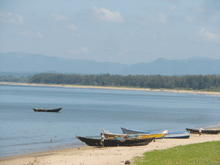 With its administrative capital Bangalore renowned as the Silicon Valley of India because of its plethora of IT (information technology) and BPO (business process outsourcing) firms, the southern state of Karnataka (pop. 57 million) has conspicuously failed to realise its full tourism development potential. While the tourism infrastructure of Bangalore (pop. 7 million) and southern Karnataka — especially the Mysore-Coorg regions is fairly well developed and attracts 5 million domestic and foreign tourists annually, northern Karnataka, particularly its pristine coastal belt, lacks the well-oiled infrastructure of commercial tourism, despite its silver beaches that rival those of Goa to the north, lush green forests, and mountain ranges of the Western Ghats that run parallel to the coast.
With its administrative capital Bangalore renowned as the Silicon Valley of India because of its plethora of IT (information technology) and BPO (business process outsourcing) firms, the southern state of Karnataka (pop. 57 million) has conspicuously failed to realise its full tourism development potential. While the tourism infrastructure of Bangalore (pop. 7 million) and southern Karnataka — especially the Mysore-Coorg regions is fairly well developed and attracts 5 million domestic and foreign tourists annually, northern Karnataka, particularly its pristine coastal belt, lacks the well-oiled infrastructure of commercial tourism, despite its silver beaches that rival those of Goa to the north, lush green forests, and mountain ranges of the Western Ghats that run parallel to the coast.
Although neither the state’s tourism ministry nor the Karnataka State Tourism Development Corporation (KSTDC) seem to be dimly aware of it, north and coastal Karnataka is a natural extension of the state of Goa to the north, offering a comparable combination of sun, sand and sea and easily accessible trekking trails in the verdant forests of the Western Ghats.
Karwar
The base point for exploring the hidden charms of northern Karnataka is the seaside town of Karwar (pop. 63,000), the administrative capital of Uttara Kannada district. Sited south of the River Kali, and nestling between the sea and high Western Ghats, Karwar is well-connected by road with Mumbai (650 km along NH 17); Goa (105 km) and Bangalore (530 km). It also has a well-networked railhead.
Boasting several splendid beaches, Karwar is a major base of the Indian Navy and a commercial centre built around the paper, food and mining industries. A five-minute walk from the crowded town centre is the Rabindra-nath Tagore Beach named after the Nobel laureate who was inspired to write his first play on these very shores. The garden at the entrance to the beach adds charm, and is a good spot to enjoy the cool of the evening. Karwar bay near Binaga is the site of the sprawling Indian Navy base. The scenic beaches of Kamat Bay and the Arga Beach, which have been subsumed into the naval base, are closed to public except during the Navy Week in early December, when school and college students flock to see the blue water might of the Indian Navy on full display.
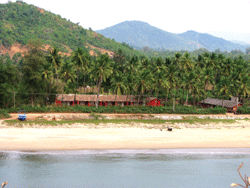 Picture postcard perfect in every way is the Devbaugh Beach, a hidden paradise accessible by a short boat ride to the far side of an eponymous offshore island. With its calm blue waters, gentle salt sprays and thick casuarina cover, Devbaugh is ideal for a quiet, away-from-it-all break. Residential accommodation is offered by the Devbaugh Beach Resort, with its furnished log huts-on-stilts. A rustic gazebo called Gol Ghar serves as its social centre and dining room.
Picture postcard perfect in every way is the Devbaugh Beach, a hidden paradise accessible by a short boat ride to the far side of an eponymous offshore island. With its calm blue waters, gentle salt sprays and thick casuarina cover, Devbaugh is ideal for a quiet, away-from-it-all break. Residential accommodation is offered by the Devbaugh Beach Resort, with its furnished log huts-on-stilts. A rustic gazebo called Gol Ghar serves as its social centre and dining room.
Even if belatedly, a tourism infrastructure is emerging on the island with snorkeling and scuba diving facilities and instruction offered by the resort. Boat rides to neighbouring islands Kurumgad, Oyster Rock and Anjadiv, the latter housing an ancient Portuguese church, are popular, with dolphins and sea otters cruising in the water. Warm and friendly tribal communities in the region offer handicrafts and impromptu song and dance rituals on request.
Back in Karwar, the 300-year-old Venkataramana temple, with some fine paintings, and Sadashivgad Fort, housing a Durga temple, are worth a visit as is the Sri Maruti temple in the town centre — a beautiful white marble structure that houses an imposing idol of the revered monkey god, Hanuman.
Accommodation. Although there aren’t any worthwhile beachfront hotels, the town centre offers budget to mid-range accommodation. Local Udupi restaur-ants serve an excellent variety of south Indian fare.
Ankola
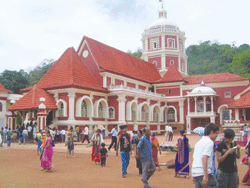 An hour’s drive south of karwar are traditional villages seemingly untouched by time, which lead to several beaches. A walk through the village to the old port of Belekiri is the gateway to long stretches of unexplored beach. This small town is surrounded by numerous temples, the most exquisite of which is the Shantadurga temple which has idols of Durga, Ganesh and others Hindu deities. The Venkatramana and Lakshmi-narayana Mahamaya temples are also worth visiting.
An hour’s drive south of karwar are traditional villages seemingly untouched by time, which lead to several beaches. A walk through the village to the old port of Belekiri is the gateway to long stretches of unexplored beach. This small town is surrounded by numerous temples, the most exquisite of which is the Shantadurga temple which has idols of Durga, Ganesh and others Hindu deities. The Venkatramana and Lakshmi-narayana Mahamaya temples are also worth visiting.
Ankola is a sleepy village from where you can access several hidden beaches good for rest, relaxation and quiet contemplation. A personal favourite is Honey Beach which can be reached by a 30-minute rickshaw ride through quaint villages surrounded by emerald paddy fields. The only accommodation available is the Honey Beach Resort which offers excellent villas with amazing views of the sea. But plenty of rooms are available in town, making Ankola a good place for an overnight stop and a base to explore the coastline. Local dhabas and busy roadside restaurants serve up a good selection of Indian and continental cuisine.
Accommodation. High-end: Honey Beach Resort, from Rs.2,500-3,000 per night. Deluxe and budget: Anand Lodge, Om Guest House, from Rs.500 onwards.
Gokarna
Unchanged alleyways lined with rows of wooden houses, ashrams and magnificent temples, define the town of Gokarna (pop. 25,000). A sacred pilgrimage centre for devout Hindus, it attracts pilgrims as well as travelers all through the year. Gokarna (literally ‘cow’s ear’) is located at the ear-shaped confluence of two rivers — the Gangavali and Aghanashini. Several Hindu texts describe this temple town as an important centre of Sanskrit learning that’s been passed down from generations of Brahmin families.
Offering an inviting mix of beaches and temples, Gokarna is best explored in the early mornings, when sonorous Vedic chants and bhajans fill the air. An early morning breakfast at Prema’s café or the Mahalaxmi with its roof-top restaurant, offer a good start to the day. Follow it up with a tour of the renowned Mahabaleshwar temple in town — dedicated to Lord Shiva.
Take in the Maha Ganapati temple in honour of the boy Ganapati, and the Venkataramana, Badrakali, Uma Maheshwari and Varadraj temples.
Gokarna beach which runs for miles, is an unspoilt refuge to relax, indulge in sand and sea and cool off on hot sunny days. On the beach there are numerous restaurants offering an array of seafoods, and ayurvedic spas with a range of rejuvenating treatments.
For the more adventurous, there are other beaches to explore. A ten-minute rickshaw ride or a 30-minute walk on the back roads of Gokarna leads to the Kudle Beach, a favourite meeting point of backpackers and budget travellers. Numerous guesthouses line the beach and most of them have restaurants that serve just about everything. Check out the Shiva Prasad and Ganga Café for a good selection of seafood.
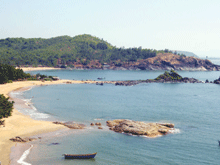 Pounded by white surf breakers of the Arabian Sea is exotic Om beach. Shaped uncannily like the auspicious ‘Om’ symbol, it affords uplifting views of unending sand and sea. Accommodation is plentiful from budget to mid-range and high-end. A good option for upscale visitors is the Om Beach Resort. Dozens of cozy restaurants mushroomed along the beach offer a good range of cuisine and tranquil ambience. The beach can be reached either by a testing trek from Gokarna town, or by autorickshaw (Rs.150).
Pounded by white surf breakers of the Arabian Sea is exotic Om beach. Shaped uncannily like the auspicious ‘Om’ symbol, it affords uplifting views of unending sand and sea. Accommodation is plentiful from budget to mid-range and high-end. A good option for upscale visitors is the Om Beach Resort. Dozens of cozy restaurants mushroomed along the beach offer a good range of cuisine and tranquil ambience. The beach can be reached either by a testing trek from Gokarna town, or by autorickshaw (Rs.150).
From Om beach a 20/30 minute trek, or a short boat ride will get you to Half-moon beach. With never more than a dozen people around, it’s a perfect refuge from madding crowds. A visit to Half-moon could be just a trip or a longer stay, as three guest houses offer excellent accommodation at budget prices. Paradise beach further down, as its name suggests, is a secluded utopian retreat. Both beaches are accessible only by foot or boat.
Accommodation. High-end: Om Beach Resort, Rs.2,500-3,000. Deluxe and Budget: Hotel Gokarna International, Spanish Place, Shanti Nivas, from Rs.800 upwards.
Badami
Once the capital of the Chalukya empire (300-700 AD), Badami is a non-descript village today. Never-theless it boasts magnificent rock-cut temple architecture which is a unique blend of south and north Indian schools. The rock-cut caves of Badami, currently populated with mischievous monkeys, are the surviving glory of this Chalukya capital gone to seed.
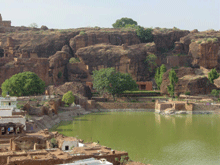 Cave 1, dedicated to Lord Shiva, is the oldest of four, dating back to 500 AD. On a cliff wall to the right of the cave is a captivating painting of Shiva as Nataraja in 81 dance postures, while the porch is dominated by a huge figurine of Ardhanarishvara. The opposite wall has an image of Harihara, a half Shiva and half Vishnu representation.
Cave 1, dedicated to Lord Shiva, is the oldest of four, dating back to 500 AD. On a cliff wall to the right of the cave is a captivating painting of Shiva as Nataraja in 81 dance postures, while the porch is dominated by a huge figurine of Ardhanarishvara. The opposite wall has an image of Harihara, a half Shiva and half Vishnu representation.
Cave 2, simplest in design of all four caves, is dedicated to Lord Vishnu. The four pillars supporting the cave are embellished with carved figurines of the mythical Yarli. The ceiling has a figure of Vishnu riding Garuda, swastikas and the 16 fish wheel, an incarnation of Vishnu. To the left of the cave is the naga (snake) couple and the right wall has a large sculpture of Trivikrama, another incarnation of Vishnu holding weapons in his hands.
Two flights of steps take you to Cave 3, perhaps the most exquisitely designed and decorated under the supervision of Mangalesha, the brother of King Kirtivarma in 578 AD. The cave entrance displays a large relief of Vishnu reclining on the serpent sesha, symbolising the cosmic ocean. Standing next to it is the image of Varaha. The ceiling is enhanced with sculpted images of Indra riding an elephant, Shiva a bull and Brahma on a swan.
Cave 4, dedicated to Jainism, is the smallest of them all. The sanctum contains an image of Adinath, the first Jain tirthankara (teacher). The right wall has an image of Suparshavantha, the seventh Jain tirthankara, surrounded by 24 teachers.
Apart from these awesome caves, Badami Fort strategically situated atop a northern hill, houses impressive temples. Malegitti Shivalaya, the oldest temple, dedicated to Shiva, had a Dravidian tower of which only the sanctum remains. The neighbouring Bhutanatha Temple sited at the edge of the Agastyatirtha tank is the best spot to view the setting sun and its golden rays reflect on the water tank. The archaeological museum displays fine specimens of carvings of the region and houses the remarkable Lajja-Gauri sculpture of a fertility cult.
Pattadakal
This neglected riverside village, 20 km from Badami, was once the second capital of the Chalukyan Empire. Built during the 7th and 8th centuries, its ruins date back to 200-300 AD. Hosting some of the most beautiful temples, Pattadakal is now a World Heritage site and a major attraction for students of Indian temple architecture.
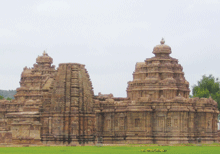 Pattadakal’s pride is the immense Virupaksha temple, with chiselled divinities covering its facade and reliefs depicting episodes from the two treasures of Indian mythology — the Ramayana and Mahabharata. In the courtyard of the temple stands an enormous pavilion hosting a sculpture of the Nandi bull in repose. Next door is the almost identical but worn-out Mallikarjuna temple, notable for its beautiful external statuary. The Papanath temple standing in silent isolation 500 metres away is worth seeing. Pattadakal is a day’s excursion from Badami. Buses and taxis are easily available.
Pattadakal’s pride is the immense Virupaksha temple, with chiselled divinities covering its facade and reliefs depicting episodes from the two treasures of Indian mythology — the Ramayana and Mahabharata. In the courtyard of the temple stands an enormous pavilion hosting a sculpture of the Nandi bull in repose. Next door is the almost identical but worn-out Mallikarjuna temple, notable for its beautiful external statuary. The Papanath temple standing in silent isolation 500 metres away is worth seeing. Pattadakal is a day’s excursion from Badami. Buses and taxis are easily available.
Aihole
The capital of the Chalukyan empire during 300-500 AD, Aihole (pop.3,140) rivals Pattadakal with its glorious temples. A few historians believe this town was the fons at origo of Chalukyan temple art, and it still hosts the earliest temples and shrines of the dynasty. Indeed with over 125 temples, Aihole is a testimony to the religiosity of the Chalukya kings, and was a centre of influence in medieval Indian art and architecture. An enclosed structure in the heart of town is the starting point of a temple tour of Aihole. The most impressive is the main Durga temple, with its semicircular apse and detailed carvings that surround a colonnaded passageway leading to the sanctum. The carvings render scenes from the Ramayana, dancers in poses, and sculpted divinities of great elegance. A small museum located next door exhibits relics and sculptures of the era.
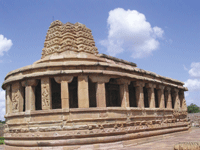 To the south of the Durga Temple are several smaller temple clusters — the Gandar, Ladkhan, Kontigudi and Hucchapaya groups characterised by their sloping roofs. Particularly remarkable is the Huchchimalli temple complex, constructed on an elevated platform. Noted for its carefully sculpted figurines, it illustrates the legends of Hindu gods Garuda, Brahma, Shiva, Vishnu and the celestial nymphs. The temple tank is also guarded by sculpted deities Brahma, Kartikeya, Vishnu, Gajalaxmi etc.
To the south of the Durga Temple are several smaller temple clusters — the Gandar, Ladkhan, Kontigudi and Hucchapaya groups characterised by their sloping roofs. Particularly remarkable is the Huchchimalli temple complex, constructed on an elevated platform. Noted for its carefully sculpted figurines, it illustrates the legends of Hindu gods Garuda, Brahma, Shiva, Vishnu and the celestial nymphs. The temple tank is also guarded by sculpted deities Brahma, Kartikeya, Vishnu, Gajalaxmi etc.
Further down the road, a mere 100 metres from the Durga temple, is the amazing rock-cut shrine of Ravanaphadi whose interior walls feature a dancing Shiva, and carvings of Varaha, Mahishasurmardini and other slender figures. And to round off the temple tour, walk to the Jain Meguti temple on a low hill top connected with a series of steps.
Most of the temple tour described above can be completed in a day. But for those with more time and inclination, there’s a KSTDC tourist home with budget accommodation. Moreover the rudimentary local eateries serve good vegetarian fare.
Accommodation. High-end: Hotel Badami Court, from Rs.1,500 (per night). Deluxe and Budget: KSTDC Hotel Mayura Chalukya, from Rs.600, Hotel New Satkar, from Rs.500.